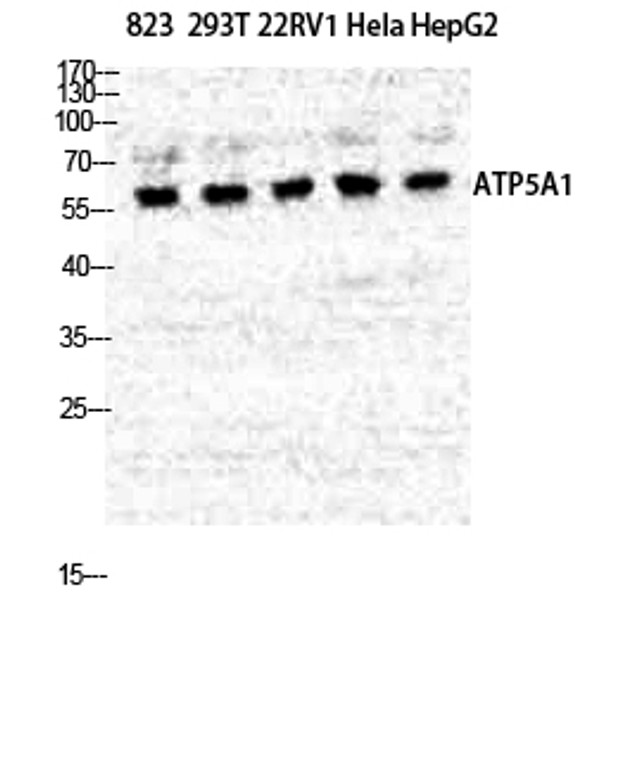| Host: |
Rabbit |
| Applications: |
WB/IHC/IF/ELISA |
| Reactivity: |
Human/Mouse/Rat |
| Note: |
STRICTLY FOR FURTHER SCIENTIFIC RESEARCH USE ONLY (RUO). MUST NOT TO BE USED IN DIAGNOSTIC OR THERAPEUTIC APPLICATIONS. |
| Short Description: |
Rabbit polyclonal antibody anti-ATP synthase subunit alpha, mitochondrial (201-250 aa) is suitable for use in Western Blot, Immunohistochemistry, Immunofluorescence and ELISA research applications. |
| Clonality: |
Polyclonal |
| Conjugation: |
Unconjugated |
| Isotype: |
IgG |
| Formulation: |
Liquid in PBS containing 50% Glycerol, 0.5% BSA and 0.02% Sodium Azide. |
| Purification: |
The antibody was affinity-purified from rabbit antiserum by affinity-chromatography using epitope-specific immunogen. |
| Concentration: |
1 mg/mL |
| Dilution Range: |
WB 1:500-1:2000IHC 1:100-1:300ELISA 1:40000IF 1:50-200 |
| Storage Instruction: |
Store at-20°C for up to 1 year from the date of receipt, and avoid repeat freeze-thaw cycles. |
| Gene Symbol: |
ATP5F1A |
| Gene ID: |
498 |
| Uniprot ID: |
ATPA_HUMAN |
| Immunogen Region: |
201-250 aa |
| Specificity: |
ATP5A Polyclonal Antibody detects endogenous levels of ATP5A protein. |
| Immunogen: |
The antiserum was produced against synthesized peptide derived from the human ATP5A1 at the amino acid range 201-250 |
| Post Translational Modifications | The N-terminus is blocked. Acetylated on lysine residues. BLOC1S1 is required for acetylation. |
| Function | Mitochondrial membrane ATP synthase (F(1)F(0) ATP synthase or Complex V) produces ATP from ADP in the presence of a proton gradient across the membrane which is generated by electron transport complexes of the respiratory chain. F-type ATPases consist of two structural domains, F(1) - containing the extramembraneous catalytic core, and F(0) - containing the membrane proton channel, linked together by a central stalk and a peripheral stalk. During catalysis, ATP synthesis in the catalytic domain of F(1) is coupled via a rotary mechanism of the central stalk subunits to proton translocation. Subunits alpha and beta form the catalytic core in F(1). Rotation of the central stalk against the surrounding alpha(3)beta(3) subunits leads to hydrolysis of ATP in three separate catalytic sites on the beta subunits. Subunit alpha does not bear the catalytic high-affinity ATP-binding sites. Binds the bacterial siderophore enterobactin and can promote mitochondrial accumulation of enterobactin-derived iron ions. |
| Protein Name | Atp Synthase Subunit Alpha - MitochondrialAtp Synthase F1 Subunit Alpha |
| Database Links | Reactome: R-HSA-1268020Reactome: R-HSA-163210Reactome: R-HSA-8949613 |
| Cellular Localisation | MitochondrionMitochondrion Inner MembranePeripheral Membrane ProteinMatrix SideCell MembraneExtracellular SideColocalizes With Hrg On The Cell Surface Of T-Cells |
| Alternative Antibody Names | Anti-Atp Synthase Subunit Alpha - Mitochondrial antibodyAnti-Atp Synthase F1 Subunit Alpha antibodyAnti-ATP5F1A antibodyAnti-ATP5A antibodyAnti-ATP5A1 antibodyAnti-ATP5AL2 antibodyAnti-ATPM antibody |
Information sourced from Uniprot.org
12 months for antibodies. 6 months for ELISA Kits. Please see website T&Cs for further guidance










